Did you know that 20% of LGBTQ Americans have experienced discrimination based on sexual orientation or gender identity when applying for jobs (Catalyst)?
Job descriptions are filled with LGBTQ exclusionary language. We found 10 examples of sexual orientation bias that show up often. Before we look at the examples, here is some background on LGBTQ.
What is the LGBTQ community?
This is a group that was referred to as the “gay community” in the past but has since evolved into a larger group of acronyms that are more inclusive. We define each acronym below and in Ongig’s Diversity & Inclusion Glossary:
LGBT — Abbreviation for lesbian, gay, bisexual, and transgender (often used to encompass sexual preference and gender identities that do not correspond to heterosexual norms).
LGBT is an acronym with multiple variations such as:
- LGBTQ — Lesbian, gay, bisexual, transgender, and queer (or questioning).
- LGBTQIA — Lesbian, gay, bisexual, transgender, queer (or questioning), intersex, and asexual (or allies).
- LGBTA — Lesbian, gay, bisexual, transgender, and asexual/aromantic/
agender. - LGBTIQQ — Lesbian, Gay, Bisexual, Transgender, Intersex, Queer, and Questioning.
- LGBTQ2+ — Lesbian, gay, bisexual, transgender, queer (or sometimes questioning), and two-spirited. The “+” signifies a number of other identities and is used to keep the abbreviation brief when written out. Some write out the full abbreviation which is LGBTTTQQIAA.
Note: Ongig’s Text Analyzer flags these and many more biased terms (with suggestions). Now, here are 10 examples of LGBTQ exclusionary language we found in job postings from Linkedin and Indeed this week:
1. guys & gals
The term “guys & gals” or “guys/gals” might make some people within the LGBTQ community feel excluded. Assuming gender in a group is discouraged, so replacing this phrase with “everyone”, “the team”, or “people” removes discrimination based on sexual orientation.
The job posting below shows sexual orientation bias because it uses “guys/gals” when referring to potential new employees:
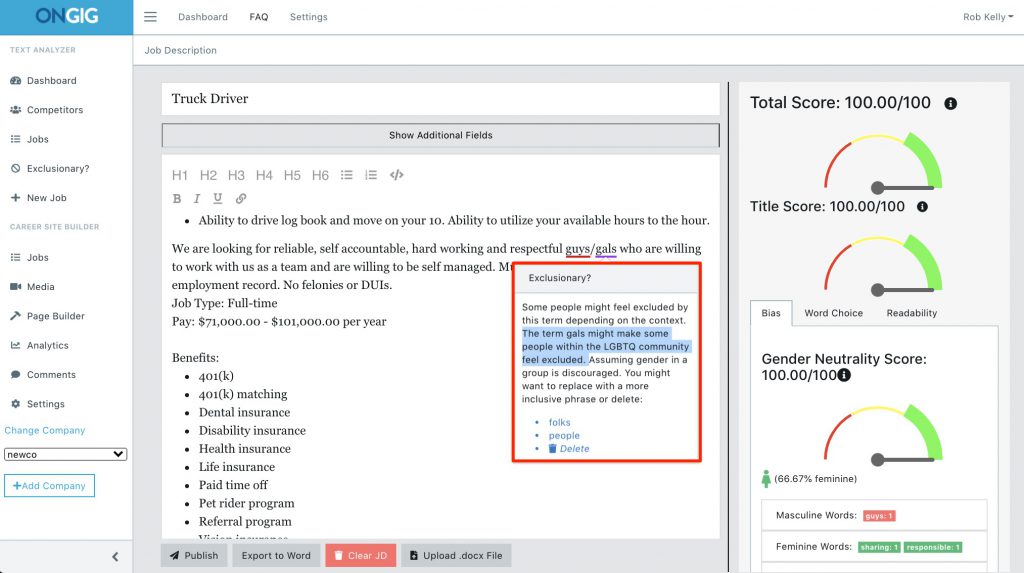
2. he/she
The terms “he/she” are another example of LGBTQ exclusionary language. Synonyms to remove LGBT gender bias, like “they” or “you”, are shown below in Ongig’s Text Analyzer, in a job description for QA Engineer.
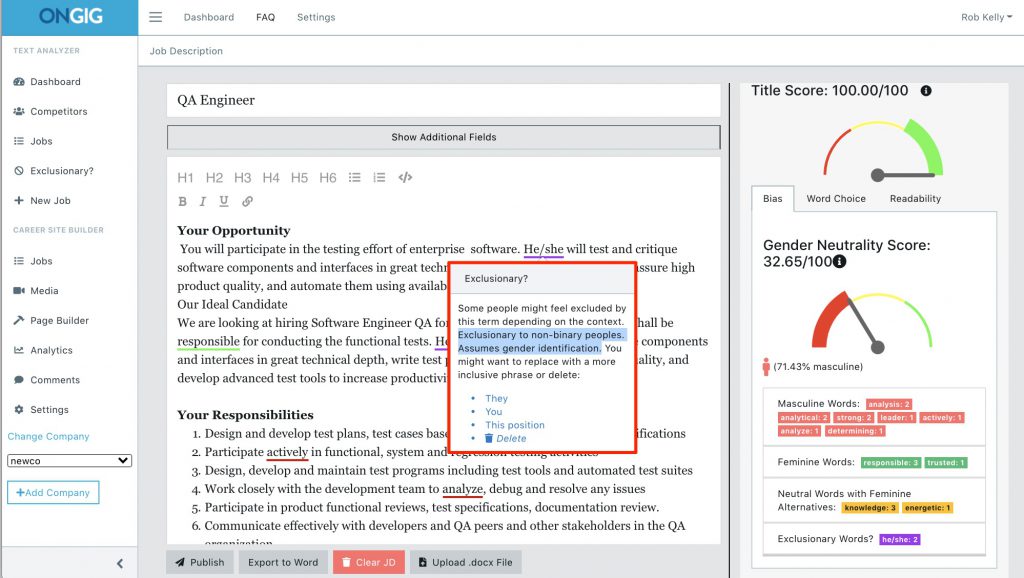
3. husbands/wives
The terms “husbands” and “wives” assume gender identification and are exclusionary to non-heterosexual people, and those who identify as non-binary. The job posting below is another example of sexual orientation bias. Replacing “husbands/wives” with “spouses/partners” is more inclusive to the LGBTQ community.
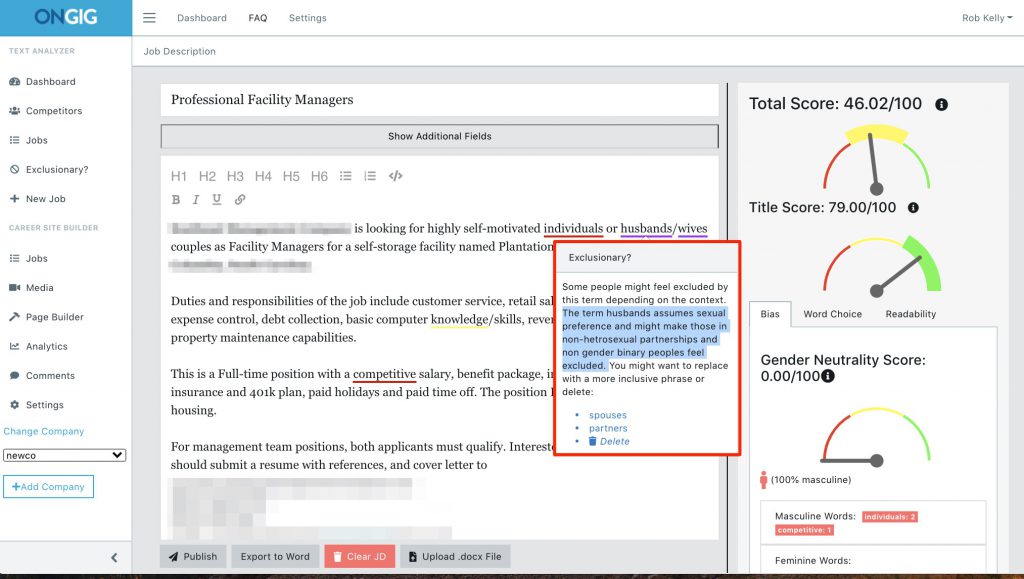
4. maternity/paternity leave
Many companies list “maternity/paternity leave” as a perk in their job descriptions, but this could be perceived as discrimination based on sexual orientation. Using more inclusive synonyms like “parenthood leave” or “parental time off” is more accepted.

5. mom/dad
The term “mom/dad” or “mom or dad” might make some people feel excluded because it assumes gender identification. Using a more inclusive synonym like “parents” remove LGBTQ exclusionary language from your job descriptions. The job posting below says if your a single “mom or dad” the company is right for you. Changing it to a “single parent” or “parent” might be more accepted by the LGBTQ community.
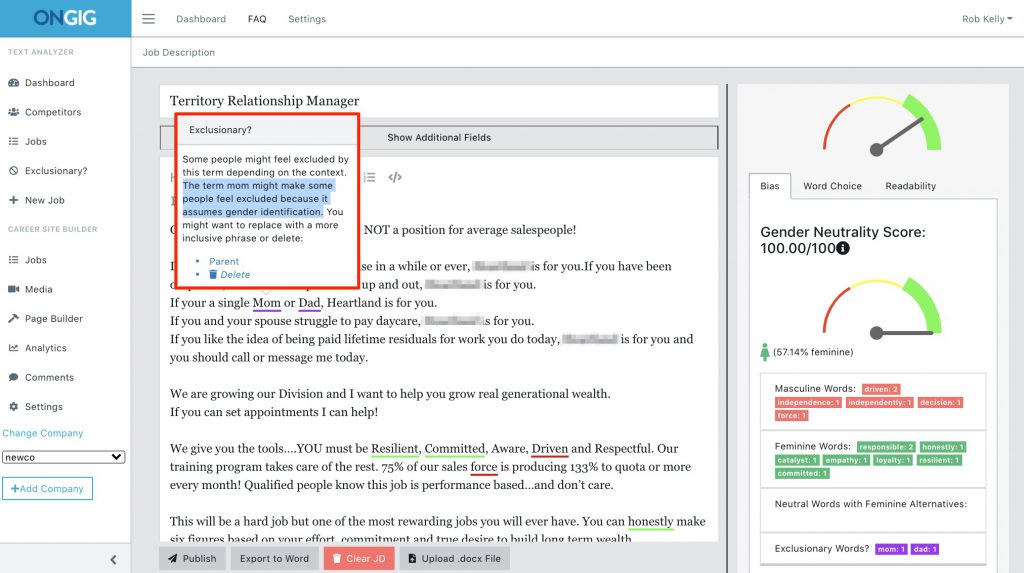
6. sexual preference
The GLAAD Media Reference Guide lists terms to avoid related to LGBTQ exclusionary language. One of them is “sexual preference”. The guide says:
“The term “sexual preference” is typically used to suggest that being lesbian, gay or bisexual is a choice and therefore can and should be “cured.” Sexual orientation is the accurate description of an individual’s enduring physical, romantic and/or emotional attraction to members of the same and/or opposite sex and is inclusive of lesbians, gay men, bisexuals, as well as straight men and women.”
The image below shows a Sales Advisor job description in Text Analyzer, with a recommendation to use “sexual orientation” instead of sexual preference to avoid offensive things to the LGBTQ community in job postings.
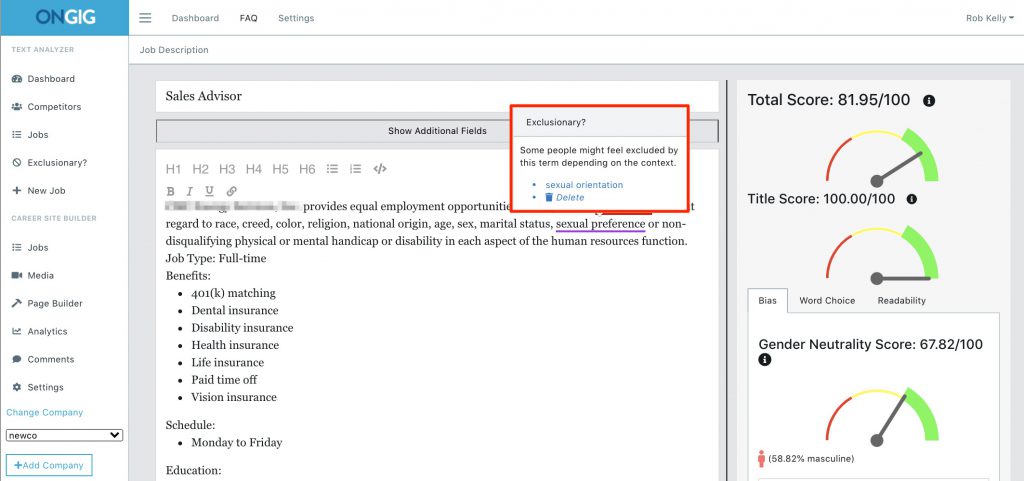
7. homosexual
Pictured below is another job advertisement that is offensive to the LGBTQ community. This is a recent job posting from a university for a Director of Compliance. The job description uses the word “homosexual”, and in a negative light. The image below shows synonyms that can remove discrimination based on sexual orientation. Text Analyzer also suggests deleting the word as a second option.
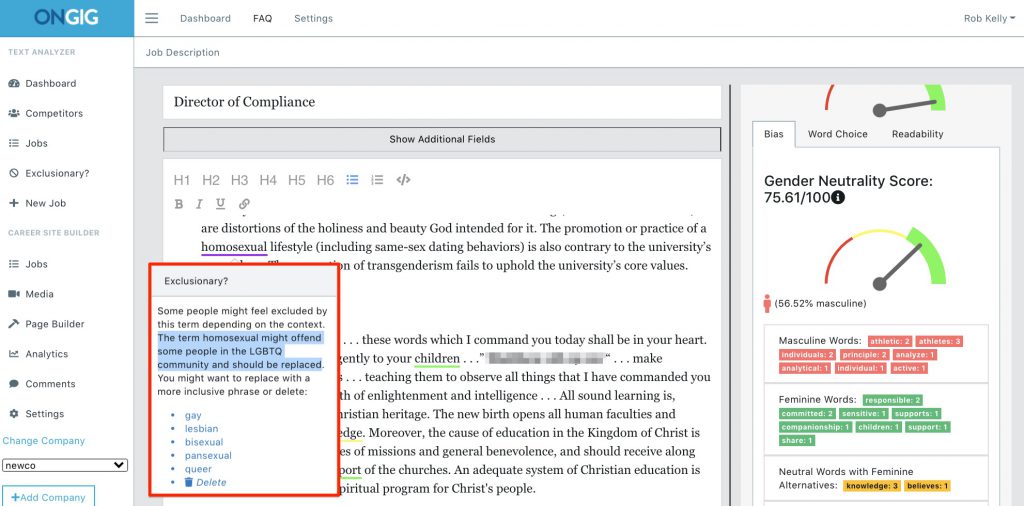
8. non-straight
A Progressive’s Style Guide lists “non-straight” as another example of LGBTQ exclusionary language. The term “non-straight” creates only 2 possible identities — straight and other.
Here is an example of a diversity statement in a JD that uses “non-straight”:
“We believe the most important and impactful art is made when we consider and commit to inclusion, diversity, equity, and access both on and off of our stage. We highly encourage folks who are Black, Native or Indigenous, People of Color, Non-Straight or Trans, Poor or Working Class, Disabled, Young, Elderly, and/or who speak English as a second language to apply.”
Many people who are not straight take pride in their sexuality and are offended by being classified as “non-” something. Using “LGBTQ+” (or a variation) or “queer” is usually more accepted (and inclusive).
9. transgendered
Using the term “transgendered” might offend some people in the LGBTQ+ community. Using people-first language is considered more inclusive. For example, if one of your roles requires the:
“Ability to be an ally to people of color, women and lesbian, gay, bisexual, transgendered, queer, questioning and intersex individuals and their allies (LGBTQIA).”
Try saying this instead:
“Ability to be an ally to people of color, women and lesbian, gay, bisexual, queer, questioning, intersex, transgender people and their allies (LGBTQIA).”
10. lifestyle choice
Another example of LGBTQ Exclusionary Language is “lifestyle choice.” A Progressive’s Style Guide lists this phrase as a term avoided (or questioned) by sex and gender identity justice activists.
Here’s a common phrase used in healthcare job descriptions using “lifestyle choice” instead of “sexual orientation” which is more inclusive to the LGBTQ+ community:
“Demonstrates respect and tolerance for all patients without regard to age, gender, race, national origin, disability status, religion and/or lifestyle choice (s).”
How to be inclusive of LGBTQ in job descriptions
Pro tip: Along with removing LGBTQ exclusionary language from your job descriptions, you can also add a statement about being inclusive to the LGBTQ community. Monster’s blog on how to be a company that attracts LGBTQ professionals says:
“In addition to adding text to your employee handbook, be sure that job seekers know that you’re a friend to the LGBTQ community as well. You can do that by including a welcome invitation in your job placements. Be explicit that all gender identities and all orientations are encouraged to apply.”
WHY I WROTE THIS:
Ongig’s Text Analyzer software helps eliminate unconscious bias. It finds offensive/exclusionary words and gives you recommendations to replace them. We’d be happy to analyze your jobs to show you examples of offensive things to the LGBTQ community. Wouldn’t you prefer to find bias before your candidates do!?
SHOUT-OUTS
- The ABCs of L.G.B.T.Q.I.A.+ (by Michael Gold)
- Lesbian, Gay, Bisexual, and Transgender Workplace Issues: Quick Take (by Catalyst)
- A Progressive’s Style Guide (by Hannah Thomas and Anna Hirsch)
- Collegian’s Inclusive Language Guide
- GLAAD Media Reference Guide
- Monster’s blog on How to be a company that attracts LGBTQ professionals
